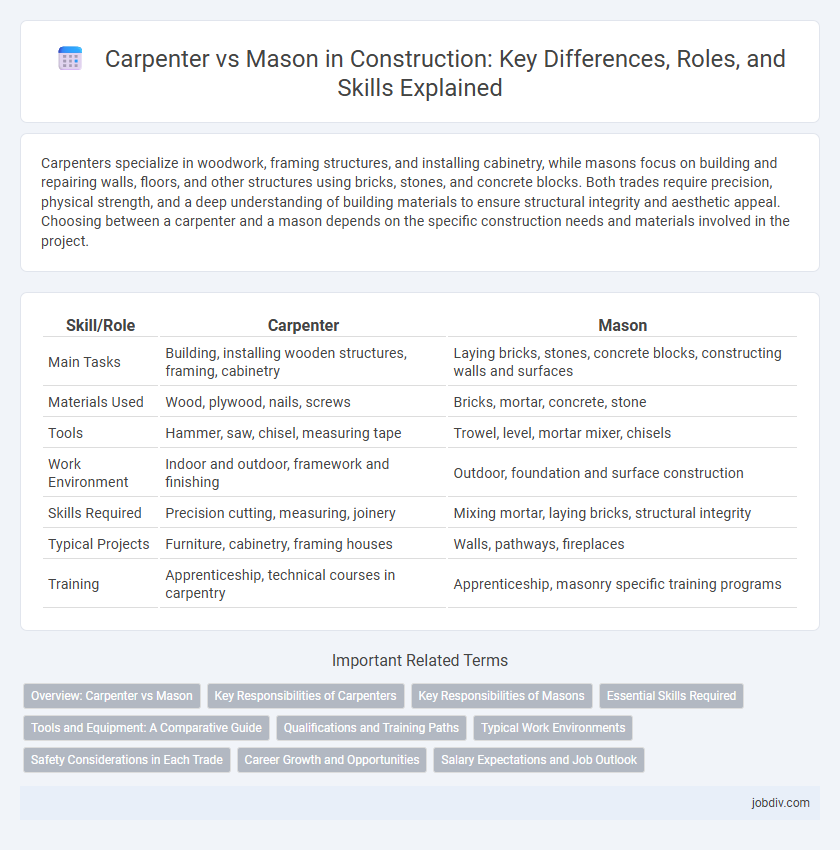Carpenters specialize in woodwork, framing structures, and installing cabinetry, while masons focus on building and repairing walls, floors, and other structures using bricks, stones, and concrete blocks. Both trades require precision, physical strength, and a deep understanding of building materials to ensure structural integrity and aesthetic appeal. Choosing between a carpenter and a mason depends on the specific construction needs and materials involved in the project.
Table of Comparison
| Skill/Role | Carpenter | Mason |
|---|---|---|
| Main Tasks | Building, installing wooden structures, framing, cabinetry | Laying bricks, stones, concrete blocks, constructing walls and surfaces |
| Materials Used | Wood, plywood, nails, screws | Bricks, mortar, concrete, stone |
| Tools | Hammer, saw, chisel, measuring tape | Trowel, level, mortar mixer, chisels |
| Work Environment | Indoor and outdoor, framework and finishing | Outdoor, foundation and surface construction |
| Skills Required | Precision cutting, measuring, joinery | Mixing mortar, laying bricks, structural integrity |
| Typical Projects | Furniture, cabinetry, framing houses | Walls, pathways, fireplaces |
| Training | Apprenticeship, technical courses in carpentry | Apprenticeship, masonry specific training programs |
Overview: Carpenter vs Mason
Carpenters specialize in woodworking tasks such as framing, cabinetry, and furniture construction, using tools like saws, hammers, and chisels to shape and assemble wooden structures. Masons focus on building with brick, stone, and concrete, constructing walls, patios, and other masonry features through techniques like laying bricks and applying mortar. Both trades require precision and craftsmanship, but carpentry centers on wood materials while masonry deals with stone and concrete elements.
Key Responsibilities of Carpenters
Carpenters specialize in constructing, installing, and repairing wooden frameworks, such as furniture, cabinetry, and structural components like walls and floors. Their key responsibilities include reading blueprints, measuring and cutting materials with precision, assembling frameworks, and ensuring structural stability and aesthetics. They often collaborate with masons, who primarily work with brick, stone, and concrete to create durable building foundations and walls.
Key Responsibilities of Masons
Masons specialize in constructing, repairing, and maintaining structures using bricks, concrete blocks, and stone, with a focus on walls, walkways, and chimneys. They interpret blueprints and apply mortar to bond materials, ensuring structural stability and aesthetic appeal. Masons also perform tasks such as cutting and shaping materials, mixing mortar, and finishing surfaces to meet design specifications.
Essential Skills Required
Carpenters require precision in measuring, cutting, and shaping wood, along with skills in blueprint reading and tool handling for constructing frameworks and structures. Masons need expertise in mixing and applying mortar, laying bricks or stones accurately, and understanding structural integrity for building durable walls and facades. Both trades demand strong manual dexterity, attention to detail, and physical stamina to perform effectively on construction sites.
Tools and Equipment: A Comparative Guide
Carpenters primarily rely on tools such as saws, hammers, chisels, measuring tapes, and power drills to shape and join wood for structures and furniture, emphasizing precision and adaptability. Masons use specialized equipment like trowels, levels, jointers, brick hammers, and mixers to handle bricks, stones, and concrete, focusing on durability and structural integrity. Both trades require safety gear including gloves, goggles, and dust masks, but their toolkits are distinctly optimized for their specific materials and construction methods.
Qualifications and Training Paths
Carpenters typically undergo formal apprenticeships that combine classroom instruction with hands-on experience, focusing on woodwork, blueprint reading, and safety protocols; certification varies by region but often enhances job prospects. Masons usually complete vocational training or apprenticeships emphasizing masonry techniques, mortar mixing, and blueprint interpretation, with certification available through trade unions or industry organizations. Both trades require physical stamina and precision, yet their distinct training paths reflect the specialized skills in wood construction for carpenters and stone or brick work for masons.
Typical Work Environments
Carpenters typically work on wood-framed buildings, residential homes, and interior fixtures, often operating on construction sites, workshops, and outdoor environments where precise measurements and custom fittings are required. Masons primarily work with brick, stone, and concrete, frequently found on building exteriors, foundations, and walls, enduring outdoor conditions that demand physical strength and attention to mortar application. Both trades require adherence to safety standards, but carpenters may experience more indoor climate control compared to the usually outdoor and variable weather conditions masons face.
Safety Considerations in Each Trade
Carpenters face safety risks such as falls from heights, sharp tools, and exposure to wood dust, requiring use of harnesses, guards, and respiratory protection. Masons encounter hazards like heavy lifting, silica dust inhalation, and chemical exposure from cement, necessitating proper lifting techniques, dust control measures, and protective gloves. Both trades emphasize personal protective equipment (PPE) compliance and site hazard awareness to minimize injury and ensure worker safety.
Career Growth and Opportunities
Carpentry offers diverse career growth through specialization in areas like cabinetry, framing, and finish work, with opportunities to advance into project management or contract roles. Masonry provides upward mobility by mastering techniques in bricklaying, stonework, and restoration, often leading to site supervision or restoration specialist positions. Both trades benefit from apprenticeship programs and certifications that enhance job prospects and earning potential in the construction industry.
Salary Expectations and Job Outlook
Carpenters in the construction industry typically earn an average annual salary ranging from $40,000 to $60,000, with job growth projected at 8% over the next decade, reflecting steady demand for skilled woodworkers. Masons, specializing in brick, block, and stone work, usually receive slightly higher wages, averaging $45,000 to $65,000 annually, driven by increased infrastructure and residential projects boosting employment opportunities by approximately 10%. Both trades require specialized skills, but masons often benefit from higher pay due to the physical demands and technical expertise needed, while carpenters enjoy more diverse job prospects in renovation and new builds.
Carpenter vs Mason Infographic

 jobdiv.com
jobdiv.com